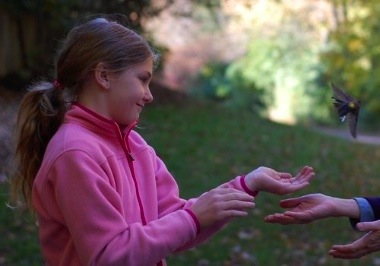 I had a rare free morning last Saturday and I realized that it was the third Saturday of October and that meant my friends Mark and Roger would be banding birds at Lowry Nature in Carver Park. When I arrived, there were dozens of bags full of small songbirds and my friend Amber was helping some Lowry volunteers process birds while Mark and Roger were out closing the nets to have time to work on the birds they had. The best part was that the kids observing the banding far out numbered the birds. They were excited to see the birds and have a chance to release them like the girl releasing the butterbut (aka yellow-rumped warbler) above.
I had a rare free morning last Saturday and I realized that it was the third Saturday of October and that meant my friends Mark and Roger would be banding birds at Lowry Nature in Carver Park. When I arrived, there were dozens of bags full of small songbirds and my friend Amber was helping some Lowry volunteers process birds while Mark and Roger were out closing the nets to have time to work on the birds they had. The best part was that the kids observing the banding far out numbered the birds. They were excited to see the birds and have a chance to release them like the girl releasing the butterbut (aka yellow-rumped warbler) above.
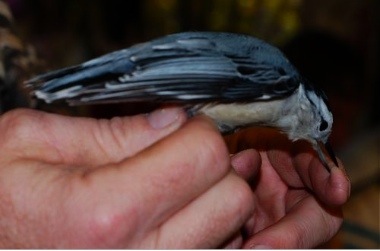 The did get in a few retraps like this nuthatch...or should we call it a fingerhatch? Most of the birds they got in were new and most were migrants.
The did get in a few retraps like this nuthatch...or should we call it a fingerhatch? Most of the birds they got in were new and most were migrants.
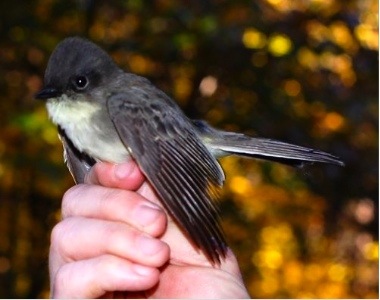 I was surprised that they got a an eastern phoebe in the nets. It was a good example of the mix of migrants we got in that day. There were quite a few insect eating birds and even though I was wearing gloves, they were still able to find some. On my way home I did observe some lingering tree swallows and chimney swifts so there must be some sort of insect population holding on despite the snow we've already had.
I was surprised that they got a an eastern phoebe in the nets. It was a good example of the mix of migrants we got in that day. There were quite a few insect eating birds and even though I was wearing gloves, they were still able to find some. On my way home I did observe some lingering tree swallows and chimney swifts so there must be some sort of insect population holding on despite the snow we've already had.
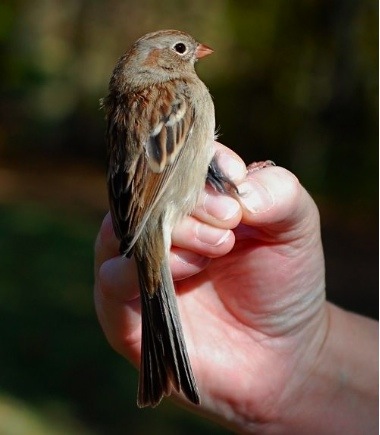 Sparrows are still around in good numbers, this is a field sparrow. These guys do not have to migrate as far as some. They spend the winter in the central and southern United States. I recall seeing them a few times in winter in my native Indiana. I will miss them while they are out of Minnesota and look forward to hearing the male's song on territory in the spring. The cool thing of banding records with tree sparrows is that we've learned based on banding that males who survive the winter, will return to almost the same territory...females do not.
Sparrows are still around in good numbers, this is a field sparrow. These guys do not have to migrate as far as some. They spend the winter in the central and southern United States. I recall seeing them a few times in winter in my native Indiana. I will miss them while they are out of Minnesota and look forward to hearing the male's song on territory in the spring. The cool thing of banding records with tree sparrows is that we've learned based on banding that males who survive the winter, will return to almost the same territory...females do not.
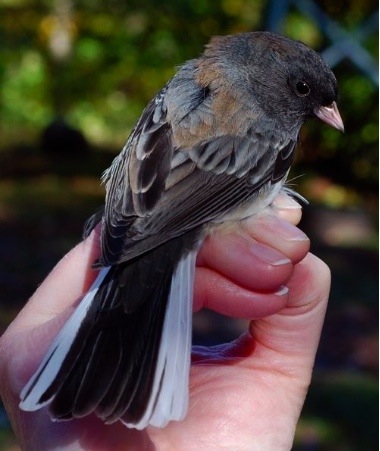 Lots of juncos were moving through (as well as white-throated sparrows mixed in with them).
Lots of juncos were moving through (as well as white-throated sparrows mixed in with them).
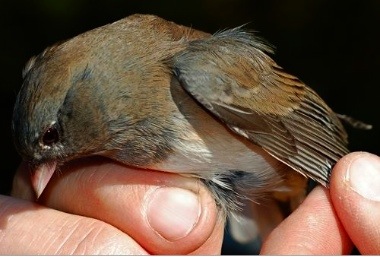 This junco was interesting. It showed hints of white wing bars. These juncos get in to a whole weird area for me. There are juncos that are called "white-winged juncos" but they are not the same as slate-colored juncos with white wing bars (I know, I know it's confusing). I'm not sure what's going on with the above bird. Mark and Roger wondered if it's some hybrid of slate-colored and white-winged junco, but tough to say. Note the white feathers around the eye--odd hybrid plumage or just lack of pigmentation?
This junco was interesting. It showed hints of white wing bars. These juncos get in to a whole weird area for me. There are juncos that are called "white-winged juncos" but they are not the same as slate-colored juncos with white wing bars (I know, I know it's confusing). I'm not sure what's going on with the above bird. Mark and Roger wondered if it's some hybrid of slate-colored and white-winged junco, but tough to say. Note the white feathers around the eye--odd hybrid plumage or just lack of pigmentation?
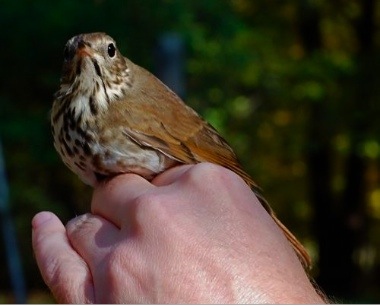 Hermit thrushes are still moving through along with tons of their cousins--robins. These birds have a bit further to go than the field sparrows. Some will spend the winter in the southern US, while others go all the way down into Central America.
Hermit thrushes are still moving through along with tons of their cousins--robins. These birds have a bit further to go than the field sparrows. Some will spend the winter in the southern US, while others go all the way down into Central America.
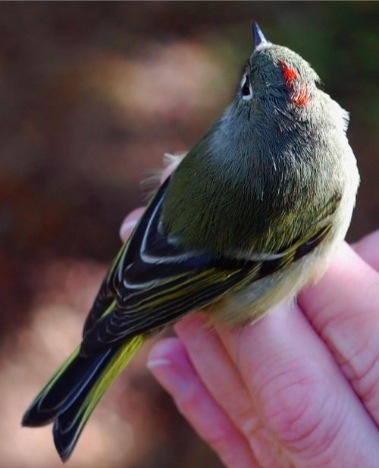 The big treat of the day in the nets for me were kinglets. Check out this male ruby-throated kinglet teasing us with a slight flash of his crown. These birds are so small, it's like taking a dust bunny out of the nets, I mean really, apart from hummingbirds, they just don't get much smaller than ruby-crowned kinglets.
The big treat of the day in the nets for me were kinglets. Check out this male ruby-throated kinglet teasing us with a slight flash of his crown. These birds are so small, it's like taking a dust bunny out of the nets, I mean really, apart from hummingbirds, they just don't get much smaller than ruby-crowned kinglets.
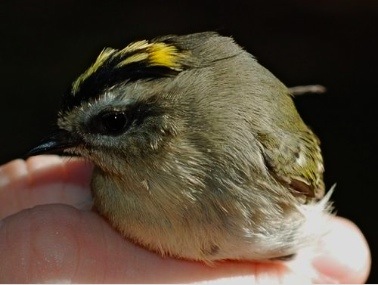 We also got in a female golden-crowned kinglet, another treat to see in the nets up close. She was soon followed by a female ruby-crowned...
We also got in a female golden-crowned kinglet, another treat to see in the nets up close. She was soon followed by a female ruby-crowned...
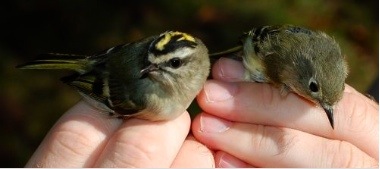 So we were able to get some comparison shots. Females of both species are different than males. The female golden-crowned lacks a bit of orange in the center of her crown and the female ruby-crowned lacks the ruby.
So we were able to get some comparison shots. Females of both species are different than males. The female golden-crowned lacks a bit of orange in the center of her crown and the female ruby-crowned lacks the ruby.
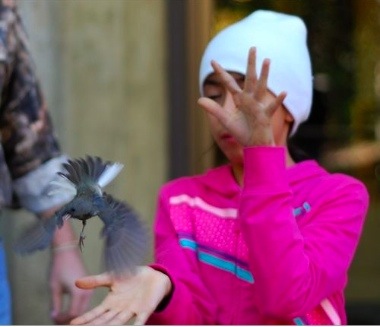 All in all it was an action packed morning. I heard Mark and Roger warning a few families who were visiting their banding operation for the first time that it's not always this busy, it's was combination of migration and a good weather front. I was just glad I had a chance to watch it. The next Carver banding day will be November 14, 2009 which is a week earlier than usual, but it's safer. The following weekend is the deer opener.
All in all it was an action packed morning. I heard Mark and Roger warning a few families who were visiting their banding operation for the first time that it's not always this busy, it's was combination of migration and a good weather front. I was just glad I had a chance to watch it. The next Carver banding day will be November 14, 2009 which is a week earlier than usual, but it's safer. The following weekend is the deer opener.
